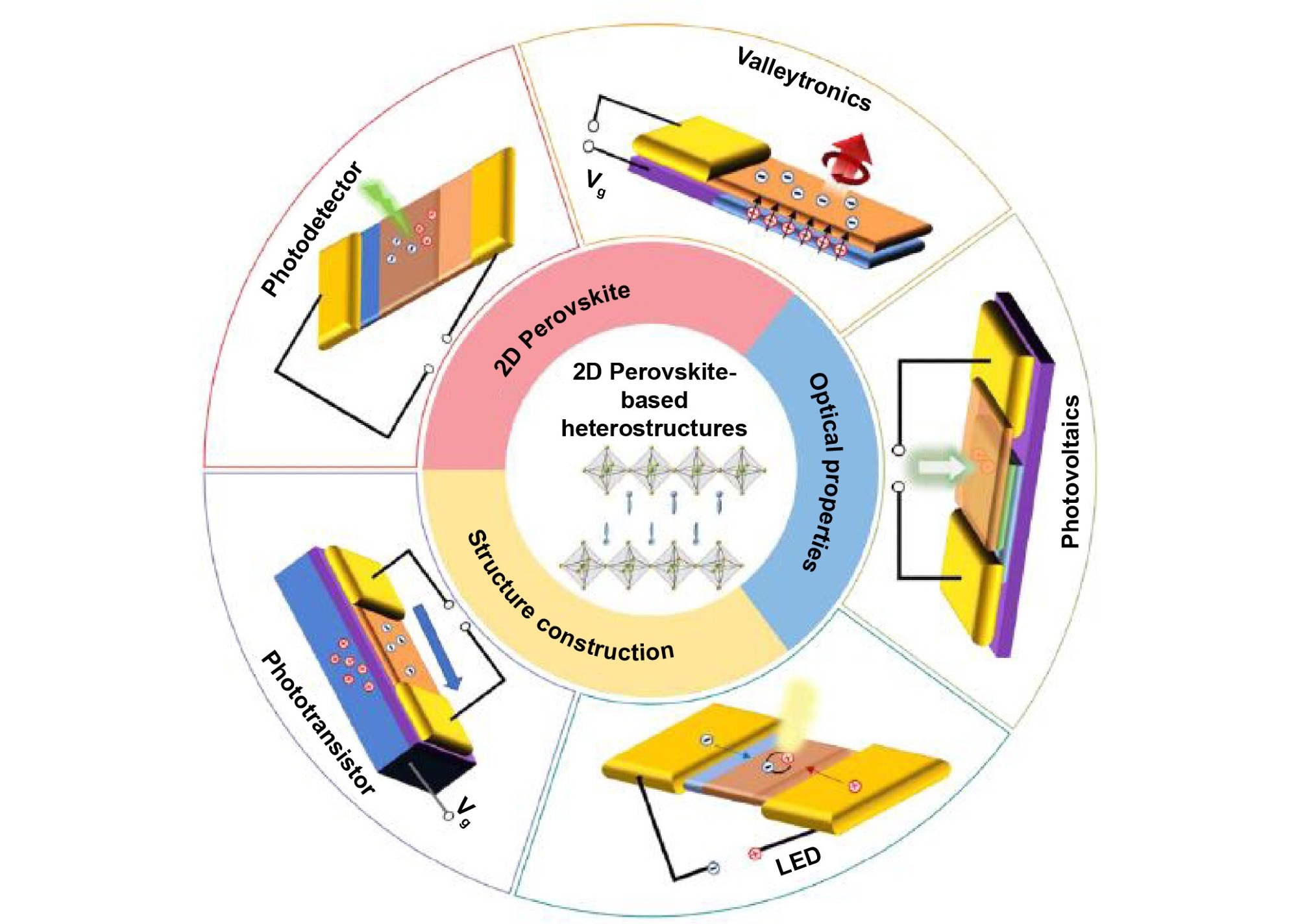Incorporating separate stacked 2D perovskites with other layered or non-layered substances can introduce novel optical and photonic characteristics, substantially expanding the heterostructures' potential functionality and applications.

In this article, the structure and physical properties of 2D perovskites will be first highlighted. The construction and characterizations of 2D perovskite-based heterostructures as well as the basic optical properties of the constructed heterostructures will then be illustrated. Furthermore, the potential applications of 2D perovskite-based heterostructures in photovoltaic devices, light-emitting diodes, photodetectors, phototransistors and valleytronic devices will be demonstrated. Finally, the current challenges and propose further research directions in the field of 2D perovskite-based heterostructures will be discussed. Image Credit: Haizhen Wang, Yingying Chen and Dehui Li.
A recent study published in the International Journal of Extreme Manufacturing summarizes the recent developments of 2D/quasi-2D perovskite-based heterostructures to expedite the exploration of undiscovered concepts and introduce a new spectrum of optoelectronic devices.
What are 2D Perovskite-Based Heterostructures?
Heterostructures, which are made by combining two or more different materials, have been an important part of many different types of optoelectronic devices, such as photovoltaic cells, light-emitting diodes, and photodetectors.
These structures are unique because they display physical properties that cannot be seen in individual components. By combining these materials, new functionalities can be achieved and explored. In recent years, the advancement of technology has allowed scientists to use atomically thin materials such as graphene, black phosphorus, and 2D perovskites to construct heterostructures.
These materials have special physical and optoelectronic properties that can be further manipulated with techniques such as doping and external fields like strain or electric fields. 2D perovskites, in particular, have been gaining a lot of attention due to their excellent properties and potential applications in next-generation optoelectronic devices.
With the ability to incorporate different types of perovskites into heterostructures, there is a vast range of new possibilities for optoelectronic devices and applications. Summarizing the research progress on these heterostructures can help lead to discoveries and advancements in the field.
Progress on 2D Perovskite-Based Heterostructures: A Literature Gap
Despite the growing interest in 2D perovskite-based heterostructures due to their unique optical and optoelectronic properties, there is still a lack of comprehensive review articles in this field.
Presently, published review studies have concentrated on heterostructures based on 3D perovskites with 2D morphologies (for instance, methylammonium lead triiodide sheets or nanoplatelets) or van der Waals nanocomposites based on 2D Ruddlesden-Popper (RP) perovskite materials.
However, when it concerns heterostructures based on 2D perovskite materials with layered and non-layered substances such as Alumina (Al2O3), 3D perovskites, and transition metal dichalcogenides (TMDs), there is still a gap in the literature.
Therefore, it is important to summarize the recent progress made in the field of 2D perovskite-based heterostructures, including the most updated research results and covering a broader range of content compared to previously reported review articles.
Highlights of the Current Review
In this study, the authors present a comprehensive overview of the latest developments in 2D perovskite-based heterostructures. The review focuses on the unique structure and physical properties of 2D perovskites and how they can be utilized to create heterostructures with enhanced optoelectronic properties.
The authors begin by emphasizing the layered nature of 2D perovskites, which allows for the creation of thin flakes that can be combined with other materials to form heterostructures. This combination leads to the inheritance of the excellent optoelectronic properties of 2D perovskites while also introducing new functionalities.
The authors then describe the construction and characterization of 2D perovskite-based heterostructures, highlighting the basic optical properties of these materials.
They also provide a thorough overview of the potential applications of these materials in various optoelectronic devices, including light-emitting diodes, photovoltaic cells, phototransistors, photodetectors, and valleytronic devices.
The lead researcher, Professor Dehui Li, commented
The rich electronic and optical physics offered by 2D perovskites renders them to be very promising for optoelectronic applications.
Future Outlook
Despite the significant progress made in the field of 2D perovskites and their heterostructures, much more investigation is still needed to fully understand their potential. In particular, several areas require further exploration.
Firstly, obtaining high-quality pure-phase 2D perovskites with many layers is essential for constructing high-quality heterostructures. Currently, it is challenging to synthesize very pure phase perovskites with a large number of layers, which hinders the extraction of intrinsic physical properties of 2D perovskites.
There is also a need to develop an efficient synthetic method for obtaining large-area, high-quality 2D perovskite heterostructures with a controllable growth orientation. Currently, no universal method exists for rationally synthesizing large-scale heterostructures with high crystalline quality.
The rich physics of 2D perovskite-based heterostructures is mostly unexplored and needs to be systematically studied for potential optoelectronic applications. For example, the effects of organic cations on charge and electron-phonon interaction need to be clarified to optimize the performance of optoelectronic devices.
Finally, there is a significant opportunity to investigate optoelectronic solutions based on 2D perovskite heterostructures as well as other layered materials. Additional features and current characteristics may be acquired by stacking diverse materials together to generate heterostructures and multi-heterostructures.
In conclusion, 2D perovskite heterostructures hold much promise for various optoelectronic applications, but much work still needs to be carried out to fully realize their potential.
Reference
Wang, H. et al. (2023). Two/Quasi-two-dimensional perovskite-based heterostructures: construction, properties, and applications. International Journal of Extreme Manufacturing. Available at: https://doi.org/10.1088/2631-7990/acab40
Disclaimer: The views expressed here are those of the author expressed in their private capacity and do not necessarily represent the views of AZoM.com Limited T/A AZoNetwork the owner and operator of this website. This disclaimer forms part of the Terms and conditions of use of this website.